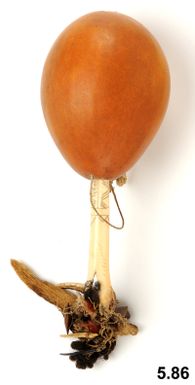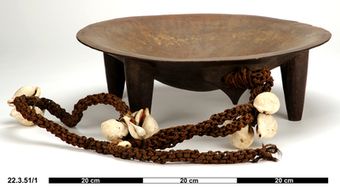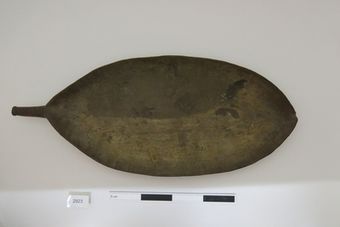Connect with Horniman Museum and Gardens
Contact this content partner to get more information about this item.
lime gourd; lime spatula (narcotics & intoxicants: chewing)
- Description:
- Lime Gourd & Lime Spatula, Mekeo people, Central Province, Papua New Guinea. The chewing of nuts from the Areca palm (Areca catechu), commonly known as betel nut, was a major recreational activity for men throughout the mainland and island groups of New Guinea. This addictive stimulant (Arecoline) was brought into the island in remote prehistory from Southeast Asia, and a complex set of artworks and tools have developed over the centuries around the drug’s preparation and consumption. Lime containers are central to the use of betel nut in New Guinea: the alkaline lime powder (usually obtained by finely grinding coral) activates the Arecoline in the nuts, and so it is needed on hand whenever the nut is chewed. Gourd containers are produced throughout Papua New Guinea, in which the ground limestone is stored, and from which small quantities are periodically removed using a saliva-wetted lime spatula and put in the mouth alongside the nuts. From the inland portion of Central Province occupied by the Mekeo people, this lime gourd is a remarkable example of the resourceful way that New Guinea peoples make use of the animals in their environment to create useful tools and artworks. Here, one of the massive leg-bones of a Southern Cassowary (Casuarius casuarius) has been carved down to serve as a combination lime spatula-stopper for this elongated and plain lime container of bottle gourd (Lagenaria siceraria). Hanging from this stopper as a decorative element is the tail of a female cuscus (Spilocuscus maculatus) – slightly bigger than a domestic cat, the largest member of the possum family, and an important wild source of red meat in New Guinea. This tail is likely to have symbolised the hunting skills of the gourd’s original owner. Alongside it hang a crab claw and a large fish vertebra, which would have been exotic rarities traded inland from more coastal branches of Mekeo society. Gourd, bone, shell, dried animal parts. Early 20th Century. Collected by Mr. A. E. Pratt and sold to the Horniman Museum in 1905. Ovoid lime gourd with southern Cassowary bone spatula with crab claw, fish vertebra, Common spotted cuscus tail, seed, human hair and feather attached to the end.
- Format:
- image
- Collections:
- Horniman Museum and Gardens
- Content partner:
- Horniman Museum and Gardens
- Availability:
- Not specified
-
Copyright status: All rights reservedFind out more about what you are able to do with this itemThis item is all rights reserved, with means you'll have to get permission from Horniman Museum and Gardens before using it. For more information, please see our use and reuse page.More informationHorniman Museum and Gardens has this to say about the rights status of this item:
http://rightsstatements.org/vocab/InC/1.0/
What can I do with this item?Non-infringing useNZ copyright law does not prevent every use of a copyright work, and this item may be hosted by an international institute or organisation. You should consider what you can and cannot do with a copyright work.No sharingYou may not copy and/or share this item with others without further permission. This includes posting it on your blog, using it in a presentation, or any other public use.No modifyingYou are not allowed to adapt or remix this item into any other works.No commercial useYou may not use this item commercially.
Related items
Welcome and warm Pasifik greetings
The information on this site has been gathered from our content partners.
The names, terms, and labels that we present on the site may contain images or voices of deceased persons and may also reflect the bias, norms, and perspective of the period of time in which they were created. We accept that these may not be appropriate today.
If you have any concerns or questions about an item, please contact us.



